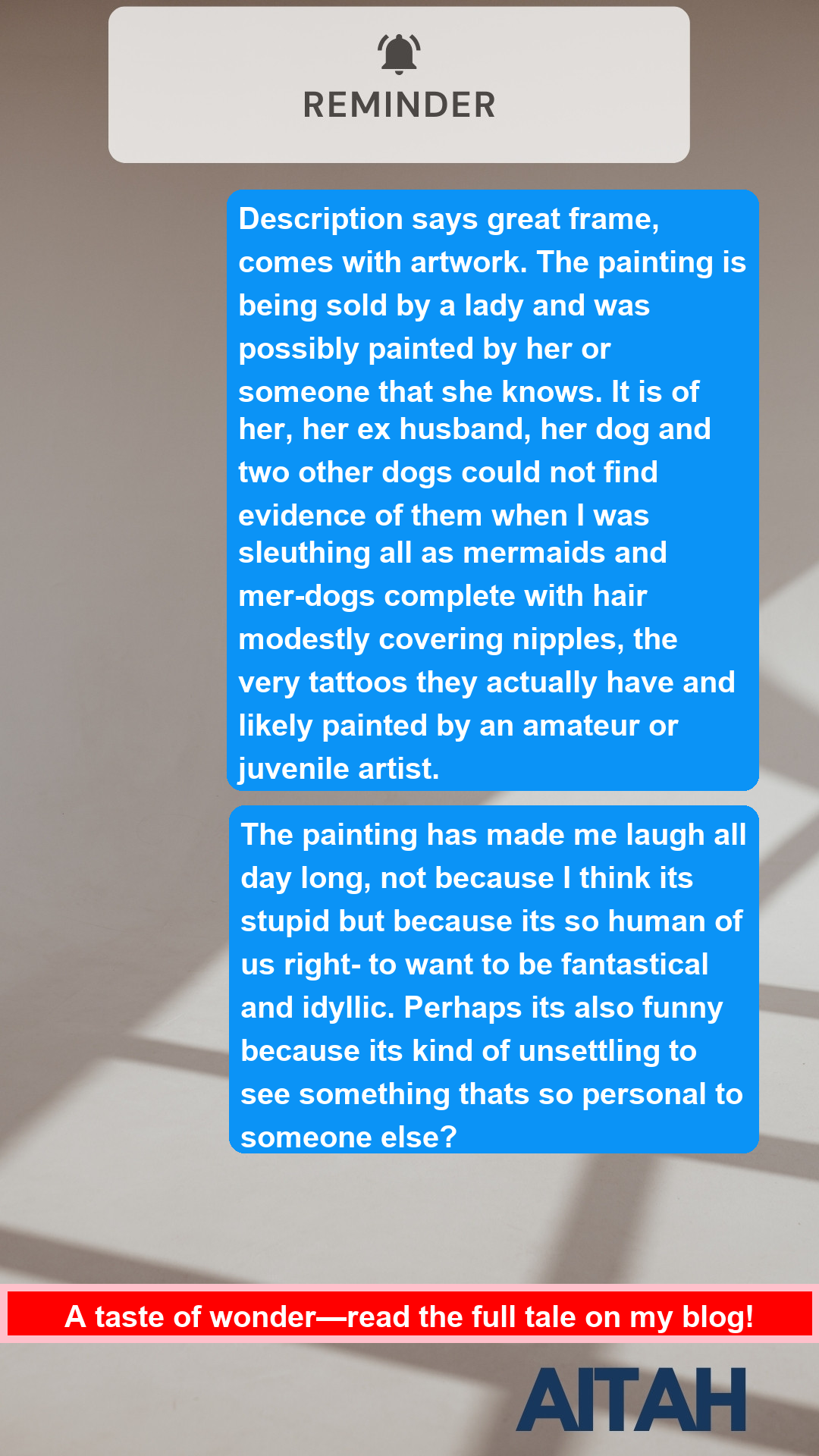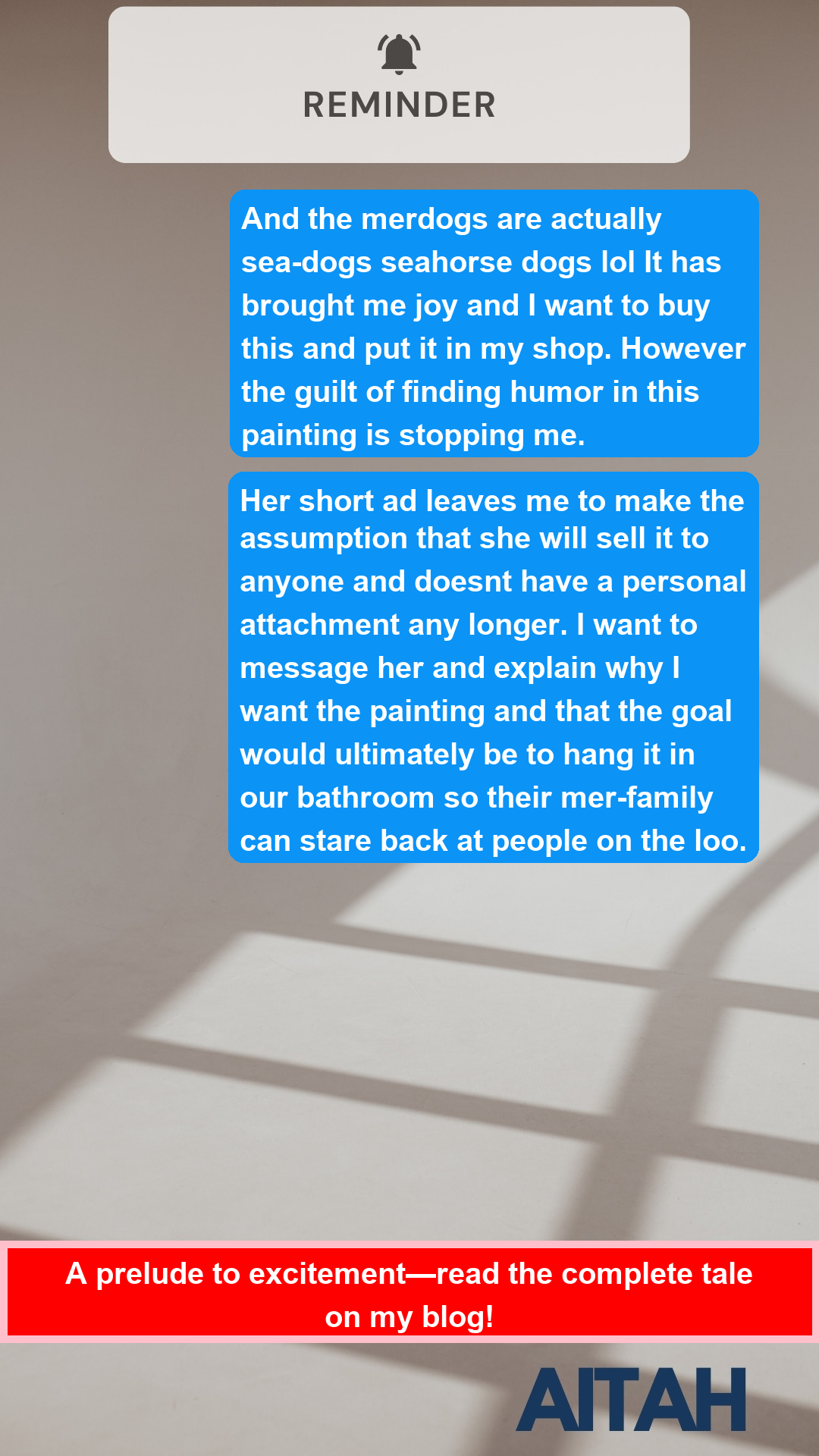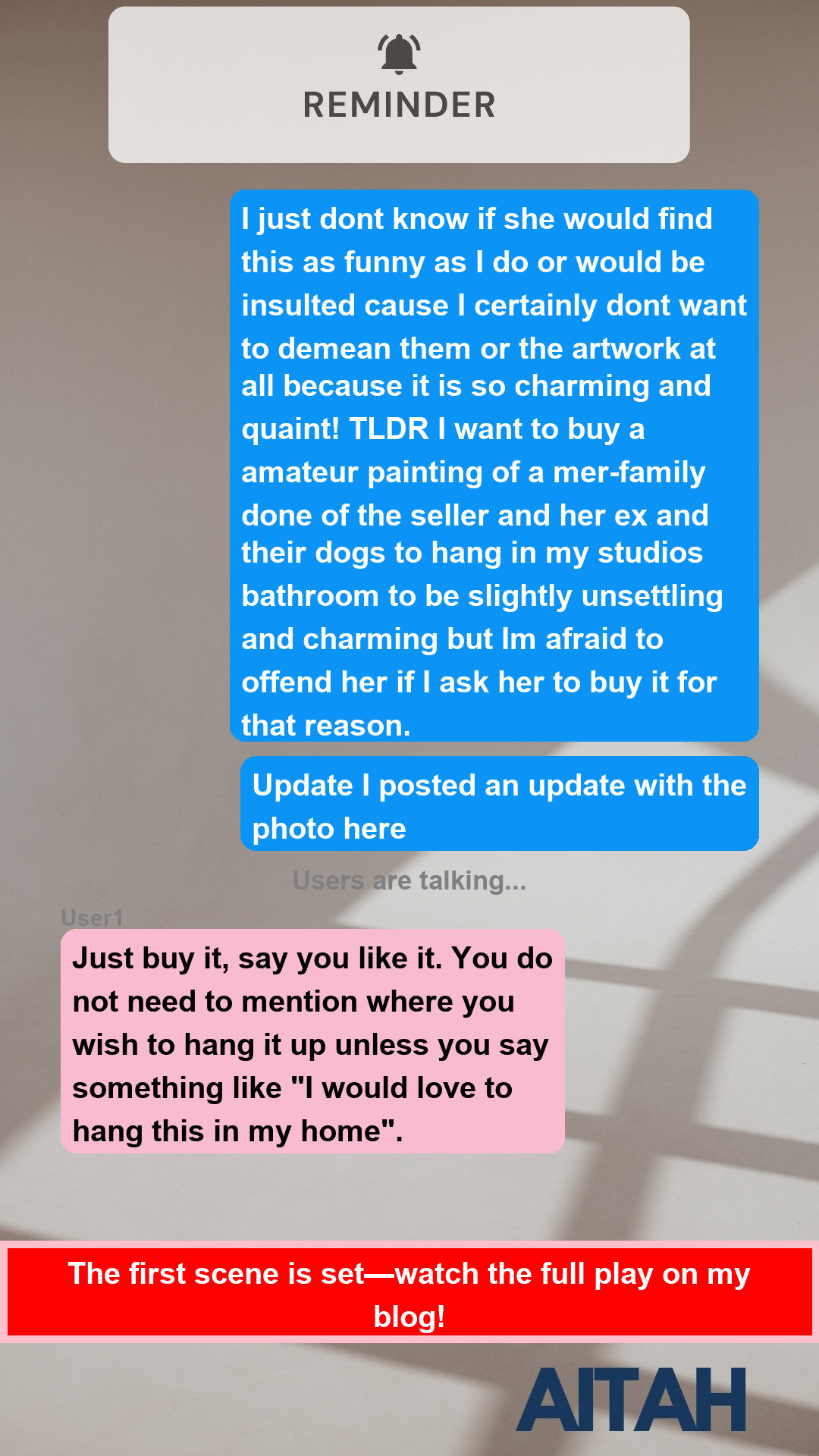WIBTA If I bought this painting and displayed it? Should I tell them why?
 Image credit: Pixabay (This is example image – Not the actual photo)
Image credit: Pixabay (This is example image – Not the actual photo)
When Art Meets Awkwardness: A Quirky Dilemma
Imagine stumbling upon a whimsical painting of a mermaid family that brings you unexpected joy, yet you hesitate to buy it because of its deeply personal nature. This story dives into the relatable struggle of balancing humor and respect when it comes to someone else’s art, especially when it’s tied to their past. The protagonist grapples with the idea of displaying this charming piece in a bathroom, questioning whether the seller would appreciate the humor or feel offended. It’s a thought-provoking exploration of how we connect with art and the stories behind it, resonating with anyone who has ever found beauty in the unconventional.
Family Drama Over a Unique Painting
This story revolves around a humorous yet delicate situation involving a unique painting and the potential for family drama. The protagonist discovers an intriguing ad for a frame that includes an unusual piece of artwork. Here’s a breakdown of the situation:
- Discovery: The protagonist finds an ad on a marketplace for a frame that is perfect for their art projects.
- Artwork Description: The ad features a second picture showcasing a painting of the seller, her ex-husband, and their dogs, depicted as mermaids and mer-dogs. The artwork is described as whimsical and possibly created by an amateur artist.
- Emotional Reaction: The protagonist finds the painting amusing and charming, appreciating its fantastical elements and the human desire for idealism. However, they also feel a sense of guilt for finding humor in someone else’s personal artwork.
- Intentions: The protagonist wishes to purchase the painting to display it in their shop’s bathroom, envisioning it as a quirky conversation starter. They hope to create a light-hearted atmosphere with the mer-family artwork.
- Conflict Resolution: The protagonist is torn between their desire to buy the painting and the fear of offending the seller. They contemplate reaching out to explain their intentions but worry that the seller may not share their sense of humor.
- Concerns: The protagonist is concerned that the seller might take offense to their plans for the painting, as they want to respect the personal nature of the artwork.
In summary, this situation highlights the complexities of family drama and the challenges of conflict resolution when humor and personal sentiment intersect. The protagonist’s dilemma reflects a broader theme of navigating relationships and understanding the emotional weight of art. They are left pondering whether to reach out to the seller and risk potential misunderstanding or to let the opportunity pass by.
Ultimately, the protagonist’s story serves as a reminder of the delicate balance between humor and respect in interpersonal interactions, especially when it comes to personal creations like art.
This is Original story from Reddit
 Image credit: Pixabay (This is example image – Not the actual photo)
Image credit: Pixabay (This is example image – Not the actual photo)
Story
So this morning, I was perusing the marketplace when I found an ad for a frame. Cool, perfect dimensions for some art projects. BUT WAIT.
There is a second picture showcasing the frame and the artwork currently in it. The description says great frame, comes with artwork.
The painting is being sold by a lady and was possibly painted by her or someone that she knows. It is of her, her ex-husband, her dog, and two other dogs. I could not find evidence of them when I was sleuthing, all as mermaids and mer-dogs, complete with hair modestly covering nipples, the very tattoos they actually have, and likely painted by an amateur or juvenile artist.
The painting has made me laugh all day long, not because I think it’s stupid, but because it’s so human of us, right—to want to be fantastical and idyllic. Perhaps it’s also funny because it’s kind of unsettling to see something that’s so personal to someone else? And the mer-dogs are actually sea-dogs, seahorse dogs, lol.
It has brought me joy, and I want to buy this and put it in my shop. However, the guilt of finding humor in this painting is stopping me. Her short ad leaves me to make the assumption that she will sell it to anyone and doesn’t have a personal attachment any longer.
I want to message her and explain why I want the painting and that the goal would ultimately be to hang it in our bathroom so their mer-family can stare back at people on the loo. I just don’t know if she would find this as funny as I do or would be insulted because I certainly don’t want to demean them or the artwork at all, because it is so charming and quaint!
TLDR: I want to buy an amateur painting of a mer-family done of the seller and her ex and their dogs to hang in my studio’s bathroom to be slightly unsettling and charming, but I’m afraid to offend her if I ask her to buy it for that reason.
Update: I posted an update with the photo here.
View the Original Reddit Post Here
Summary of Reddit Comments
The top Reddit comments indicate a strong consensus that the buyer is not obligated to disclose their intentions for displaying the artwork. Users emphasize that once the item is purchased, it belongs to the buyer, and they should feel free to enjoy it without concern for the seller’s preferences. This perspective highlights a broader moral takeaway about ownership and personal freedom in art appreciation.
Verdict: NTA
Expert Advice for Resolving the Conflict
In navigating the delicate situation surrounding the unique painting, it’s essential to approach the conflict with empathy and understanding. Here are some practical steps for both the protagonist and the seller to consider:
For the Protagonist:
- Reflect on Your Intentions: Before making a decision, take a moment to clarify your intentions. Acknowledge that your appreciation for the painting is genuine and that you see it as a source of joy and humor.
- Reach Out to the Seller: Consider sending a polite message to the seller. Express your admiration for the artwork and explain your vision for displaying it in a light-hearted manner. This can help alleviate any concerns about potential offense.
- Be Honest but Respectful: When communicating with the seller, be honest about your intentions while also being respectful of their feelings. Acknowledge that the painting holds personal significance and that you appreciate its uniqueness.
- Prepare for Any Response: Understand that the seller may have mixed feelings about the sale. Be prepared for any response, whether positive or negative, and remain respectful regardless of their reaction.
- Consider Alternatives: If the seller expresses discomfort with your plans, be open to discussing alternatives, such as displaying the painting in a different context or finding another piece that aligns with your vision.
For the Seller:
- Reflect on Your Feelings: Take time to consider your emotional attachment to the painting. Acknowledge that while it may hold personal significance, it is also an opportunity for someone else to appreciate it in a new way.
- Communicate Openly: If the buyer reaches out, engage in an open dialogue. Share your thoughts and feelings about the artwork and how you envision it being displayed.
- Consider the Buyer’s Perspective: Understand that the buyer may genuinely appreciate the whimsical nature of the painting. Try to see the situation from their perspective and recognize their desire to bring joy to others.
- Set Boundaries if Necessary: If you feel strongly about how the painting should be treated, communicate your boundaries clearly. It’s okay to express your preferences while remaining open to discussion.
- Embrace the Opportunity: If the sale goes through, consider it an opportunity for your artwork to bring joy to others. This can be a positive way to let go of the piece while still cherishing the memories associated with it.
Ultimately, the key to resolving this conflict lies in open communication and mutual respect. By addressing each other’s feelings and intentions, both parties can navigate this situation in a way that honors the emotional weight of the artwork while also allowing for personal expression and enjoyment.
Join the Discussion
 Image credit: Pixabay (This is example image – Not the actual photo)
Image credit: Pixabay (This is example image – Not the actual photo)
What do you think? Would you have handled this differently?
Share your thoughts below! Vote: Do you agree with Reddit’s verdict?





